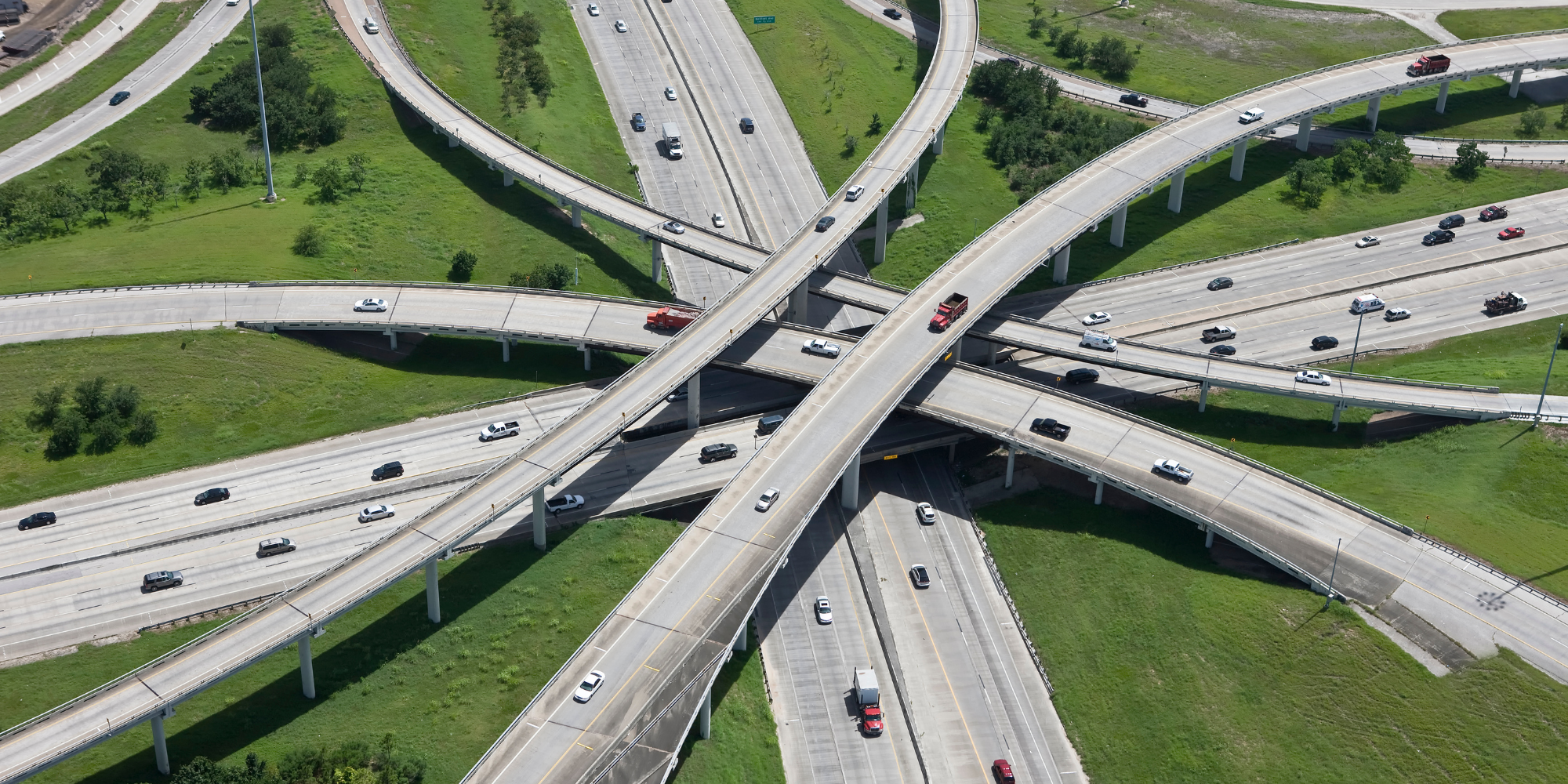Opportunity for Communities
Imagine if a highway was suddenly being built directly in the middle of your neighborhood. While our nation’s 1960s highway investment connected the county in ways that had not been possible before, it also divided communities purposefully with highways and upended minority neighborhoods.
The U.S. Department of Transportation (USDOT) estimates that between 1957 and 1977 more than almost half a million households were displaced by the construction of the U.S. highway system. Most of those households were in urban communities with low incomes and communities of color. The results of this federal highway investment included a loss of community assets such as businesses, schools, churches, and green spaces, decreased property values, safety impacts, and disparities in health outcomes. Additionally, the Center for Disease Control and Prevention has found that people of color who live near major highways have disproportionate health effects from air pollution.
Now, local governments including cities, towns and villages are excited to work together to reverse these problematic projects and reconnect neighborhoods through the U.S. Department of Transportation’s new Reconnecting Communities Pilot Program (RCP). Over the next five years, the Bipartisan Infrastructure Law (BIL) will fund $1 billion into programs supporting planning, capital construction, and technical assistance for the RCP grants.
Grant funding will largely go to projects that equitably and safely restore the connection between communities through the removal, retrofitting, mitigation or replacement of infrastructure that creates barriers to mobility, access to goods, services or jobs. Local governments, metropolitan planning organizations (MPOs), nonprofit organizations, states and facility owners can all apply or partner for RCP grants. Because of the scope of these projects, many entities will likely need to partner and apply together.
With the funds provided in the RCP grant program, cities, towns and villages stand ready to work with partners to address mobility barriers that have directly impacted their communities historically and reestablish their original connectivity.
Projects Eligible for Reconnecting Communities Pilot Funding
RCP grants can impact infrastructures such as roads, streets, parkways, and railroad tracks where they create barriers to community connectivity. These infrastructure barriers must disrupt mobility access between neighborhoods because of issues like high speeds on roads which make pedestrian crossings dangerous, grade separation, or other design factors.
Within the RCP program, there are three types of grants:
- Planning grants
- Capital construction grants and
- Technical assistance grants.
For planning grants, only local governments, MPOs, state governments, and nonprofit organizations can apply. Eligible planning grant activities include:
- Conducting studies that look at:
- Current traffic patterns on the infrastructure proposed for removal
- Transportation network capacity
- Alternative roadway designs or other uses for the right-of-way
- Impacts on the mobility of freight and people
- Impact on the safety of the traveling public
- Cost
- And the economic and environmental impacts
- Efforts to engage the public to provide input into a plan to remove and convert eligible infrastructure
- Other planning activities determined by the USDOT that are required in advance of the removal, retrofit or mitigation of existing infrastructure to restore community connectivity.
Capital construction grants can be applied for by the facility owner of the infrastructure (most likely a state or local government) after all necessary planning studies and activities have been completed. Partnership applications between a facility owner and other entities are allowed to apply together. Eligible capital construction grant activities include:
- The removal, retrofit or mitigation of an existing road, street, parkway, railroad or another barrier that inhibits community connectivity.
- The replacement of infrastructure that divided a community with a new road, street, parkway, railroad, etc. that re-connects a community.
Technical assistance grants can also be used to help engage the community in transportation planning and identify solutions to infrastructure barriers that have split communities, lack safety, are unreliable or are devoid of affordable transportation options. USDOT will prioritize technical assistance for underserved, overburdened and economically disadvantaged communities.
How Cities are Reconnecting Communities Today
Nashville, TN
In Nashville, TN, city leaders are working to address racial redlining and fix safety design flaws that resulted from the development of the I-40 freeway that was constructed in the 1960s and ran through a thriving predominately black neighborhood. Today, city leaders are proposing to build the Jefferson Street Multimodal Cap & Connector to reconnect the neighborhoods divided by I-40 with two specific goals. First, the cap would represent a commitment by the city to help this historically black community heal from the social and economic impact of the freeway’s construction, and second, the cap would dramatically improve mobility, access, air quality, noise impacts, and safety.
The project is expected to cost $120 million dollars and create approximately 1,124 jobs. There will be an anticipated additional 4 acres of public space for residents to access and enjoy. Once completed, the project will make the community a safer and more connected place, generating economic and social value for the entire community.
Las Vegas, NV
In Las Vegas, NV, a large transportation project aims to break down barriers and reconnect the community. Charleston Boulevard serves as the main road connecting the east-west communities of the area and runs through the middle of downtown. The Charleston Boulevard underpass is heavily deteriorating after its 70+ years of heavy use. As the years have passed, the road has become a physical and socioeconomic divide between the city’s more affluent western suburbs – with better access to healthcare, employment and education – and the marginalized communities located on the east side of Las Vegas. The underpass also serves as a large safety hazard to all users.
The Charleston Boulevard project will effectively improve connectivity between communities and resolve some of the driving safety concerns. Lowering the Charleston Boulevard Underpass and reconstructing the existing roadway into a wider boulevard with three lanes, a new bike lane, and wider sidewalks will better connect the communities on the East and West in Las Vegas.
Buffalo, Rochester, Syracuse, Hunts Point, and The Bronx in New York City, NY
Areas in New York including Buffalo, Rochester, Syracuse, Hunts Point, The Bronx, and the Cross Bronx Expressway will be enacting impactful projects that look to reunite and reconnect communities through a variety of ways. The highway expansions of the post-World War II era deeply affected communities of color as the major roads tore through the fabric of these neighborhoods. Alternative ways of seeking connection through neighborhoods that are environmentally sound and feasible will be explored for a major road project of the Kensington Expressway. Other areas will receive investments to create safer and more reliable transit networks and upgrades that demonstrate landscapes designed to bring communities together, and expanded opportunity for pedestrians and bikers to access routes.
When completed, these projects will serve to address the separation of communities by the highway system of the past and provide more diverse and creative transit opportunities from the Bronx downstate to Buffalo and Syracuse upstate.
St. Paul, MN
In St. Paul, MN, efforts are being implemented to revisit a portion of the I-94 highway that runs through a large black neighborhood, called the Rondo neighborhood. I-94 is one of the larger and main highways in this area and devastated the black community in this area in its original construction. ReConnect Rondo is a nonprofit organization leading advocacy efforts to revitilize the Rondo neighborhood through the creation of a land bridge over several blocks of I-94 to create an African American cultural enterprise district.
Get Ready to Apply
Start with USDOT
Be sure to visit the RCP home page to sign up for email updates and more information. If you have further questions, you can contact ReconnectingCommunities@dot.gov.
USDOT held a webinar on May 19th to cover the upcoming opportunity that RCP presents to communities. Local leaders interested in learning more about RCP grants should start by watching the recorded webinar. A link to the recording can be found here.
Determine which RCP grant will work best for your local community
When applying for a RCP grant, cities, towns and villages will want to begin by determining which grant – planning, capital construction, or technical assistance – they want to apply for. Next, do your homework on the history of the highway building in the area and where communities along the highway still have challenges today because of the past choices. Municipalities can identify where infrastructure bifurcated historic minority communities, resulting in barriers to connectivity. Infrastructure that causes mobility, safety, or public health issues in underserved communities are ideal recipients of RCP grants. If your community decided to apply for a capital construction grant you will need to make sure that your project meets the prerequisites such as completing any feasibility study, ensuring those plans are consistent with other regional or state plans and that community outreach to impacted stakeholders is comprehensive.
Find Partnership
To make a grant application stronger, local leaders can start identifying key stakeholders who will be impacted by a RCP grant or must be involved such as the highway owner which is often the state department of transportation. Hence, key stakeholders include departments of transportation, planning, health, private sector partners and community groups. When working with community partners, municipal leaders should think about how to engage historically underrepresented communities that have traditionally been left out of transportation decision-making processes or were previously impacted by a federal infrastructure investment that historically separated a community. Be diligent that the outreach processes meet the community where they are today with helpful strategies that encourage participation.
Confirm your City’s Unique Federal Identifier
Most cities have a point of contact in charge of their federal grant credentials which will be required to submit any application to USDOT. Starting April 4, 2022, the Data Universal Numbering System (DUNS) number which has traditionally been used to apply for grants on grants.gov was replaced with the Unique Entity Identifier (UEI). If your city, town or village is already registered with SAM.gov an UEI number has already been assigned and is viewable at SAM.gov. If your municipality does not have a UEI number yet, U.S. agencies are encouraging entities to apply for an UEI number immediately in order to be able to apply for grants.












